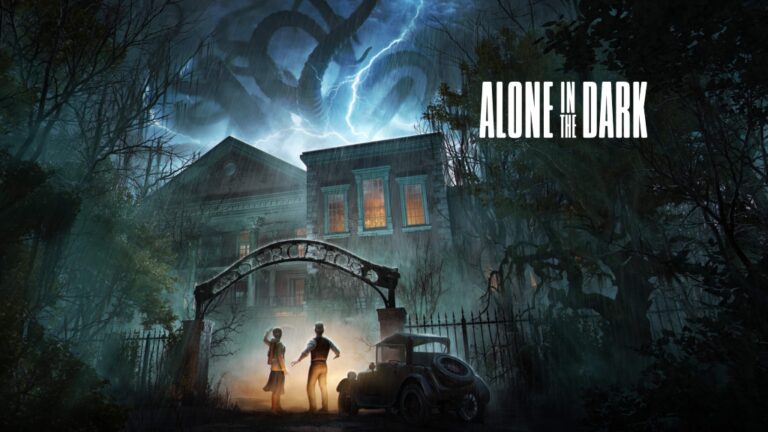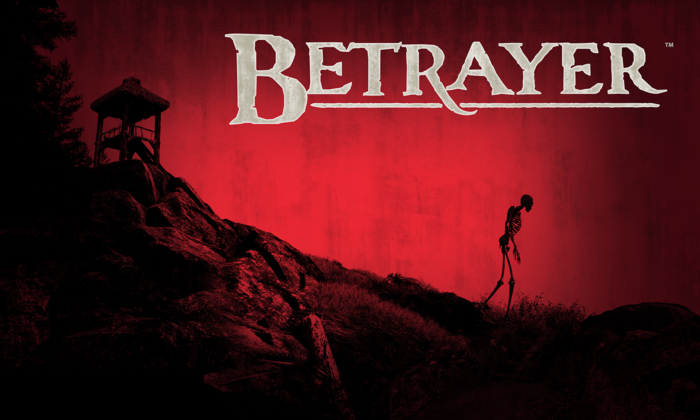
Betrayer developer Blackpowder Games is a studio founded by industry veterans from Monolith Productions, who are known for the F.E.A.R. and Condemned series. Knowing this, I expected quite the spooky adventure with Betrayer, but instead I found this game to be overly vague, repetitious, and plain boring.
The game starts off with an unnamed protagonist awaking on the shoreline of The New World. Betrayer takes place in the 17th century as European colonization has begun to take root in the Americas. The protagonist has no real personality or vocals. The game’s dialogue is entirely text-based and all we know about the character is that he hails from England. After his ship becomes damaged in travel, he winds up in a land with a series of seemingly abandoned English settlements.
The first thing you’ll notice about Betrayer is its art style; the game’s visuals are black and white, with important objects and creatures colored a vibrant red. The color settings for the game can be tweaked to play in either full color or somewhere in between that and its default. The game’s visuals are perhaps the best part of the game for me. The entire game emanates an aesthetic reminiscent of illustrations from the time period that it takes place in. Betrayer‘s art direction is one that should be commended, as it makes up for what the game’s visuals lack in terms of texture quality and the polygon count.
The second element of the game that I appreciated was its sound. Betrayer‘s stealth gameplay partially relies on the use of wind as a means to bypass enemies without them hearing you; in tandem with the game’s visuals, the sound design when exploring the stylized world creates a living and breathing art piece. Hearing a gust of wind come through and seeing the trees and grass spring to life is a visual treat.
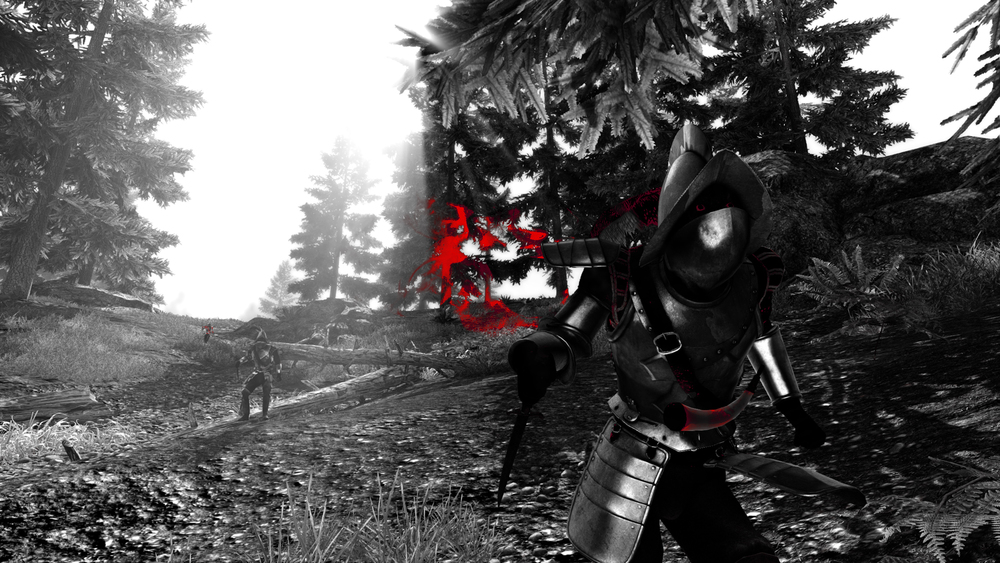
Places of interest and objectives are found and pursued by the use of sound. Players must press the listen button to hear whispers within the environment and head in the direction that emanates the loudest whisper. This system is best experienced with the use of headphones, as it can be a very subtle sound cue.
As for the gameplay, I feel that Betrayer is lacking considerably. Somewhat comparable to Far Cry 3, Betrayer’s open-world gameplay requires players to travel from point to point with a consideration to stealth tactics to avoid enemies. Being set in a series of forests with lush grass and trees, one would expect the game’s mechanics tactics to extend beyond the player accidentally making sound or being within eyesight. Once you’re spotted by enemies, the only remaining option is to somehow kill them all, or die. Fleeing from enemies is near-impossible without going across a map’s threshold into a different area.
The primary enemy type, which are Conquistador-monsters, can be avoided by staying out of sight and not creating noise in between bouts of wind. Another enemy type, which appears to be the land’s natives do not care at all for stealth as they will suddenly appear from nowhere and pursue a player until the ends of the Earth. Herein lies one of my biggest gripes with the game: it’s just incredibly frustrating and oddly difficult due to inconsistencies and the lack of basic stealth mechanics like evasion. Exploring areas becomes a tiresome task when overpowered enemies can’t be escaped.
When I say that enemies are overpowered, it’s not only because it’s impossible to escape their pursuit. Combat in Betrayer is done with a variety of bows and guns, which can be upgraded, but I find them to be relatively weak and in some cases imprecise – the bow’s shot actually hits above the reticule rather than below. Upgrades in the form of charms can be found to improve player stats like reload times, odds of being seen by enemies, and health.
In the game’s store, better weapons can be purchased, with improvements to damage, along with ammunition. The game’s upgrade system and store should improve the game’s combat difficulty, but it doesn’t. By the time I unlocked better weapons and stat-boosting items, I was about fed up with game already. It’s not just myself that had issues with enemy difficulty, either; during my course of playing this game, a patch was released to relabel the normal difficulty to hard. You would think this would have been addressed prior to the transition from Early Access to full release, but it wasn’t.
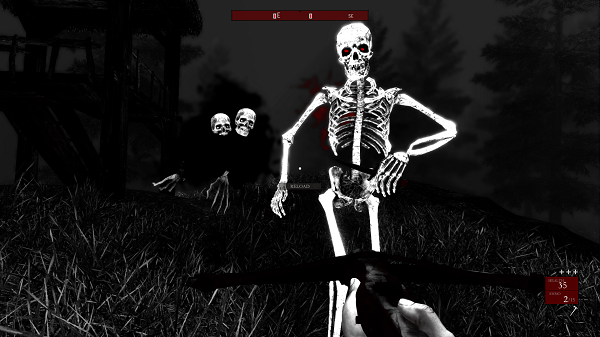
Originally, upon death, players would lose their money and would have to retrieve it with the risk of permanent loss if they were to die before requiring it. This feature did the game no favors as it only heightened the frustration that stemmed from the game’s shoddy stealth and meek combat. This too was addressed in a post-release patch that turned item-loss off by default.
When its not the combat that’s frustrating or tedious, it’s the story and its objectives. Essentially, the game boils down to solving the deaths of those who once inhabited the English colonies. The uncovered deaths of these people may occasionally be interesting, but after several hours it becomes beyond fatiguing. You’re tasked with finding a ghost that has lost something that will help them remember the time before their death, or delivering clues to multiple ghosts so that a slightly larger story behind their lives is revealed. This repeats itself several times in each of Betrayer‘s zones. The game’s story is rarely rewarding, interesting, or compelling. After several hours, I could care less why one of these ghosts had killed someone. Find clues, give clues to ghost, find out why the ghost is a ghost, and then die a whole lot in between – that’s the gist of Betrayer and I can’t say that I’m a big fan of it.
Each of Betrayer‘s colonized zones, which are comprised of one or two settlements or a base, can be explored in both a light or dark spirit world. Upon ringing a town’s bell, players can enter and leave a darker version of the world where spirits can be talked to and new enemy types reside. Clues discovered in the light world must be brought to the appropriate spirits within the dark world in order to awaken their memories and uncover their stories. In order to proceed with the game’s unraveling storyline, players have to alternate in between worlds in a monotonous rhythm.
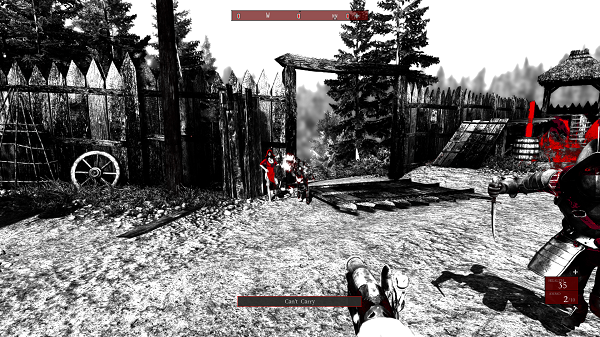
I wanted to like Betrayer. When I first laid eyes on it I was smitten with its monochromatic art style and stealth-based gameplay. I still want to like the game, in fact, but I just can’t. Betrayer is a game that I’m sure some people will enjoy, but it’s just not for me. It has enough elements that I can appreciate its ideas and gameplay to some degree, but how it comes together didn’t appeal to me. Its story is ambiguous in an uninteresting way, its stealth mechanics leave much to be desired, and its objective structure is simply a series of fetch quests for little narrative reward.
The sum of Betrayer‘s parts are not horrible by any means, but disappointing and irksome. The fact that the game began crashing on me when I needed access to the store to restock ammo did it no favors, either. That was the last straw and I did not reach the end credits (not that it would do anything to make the overall experience any better if I had). For an indie title developed by a small team, Betrayer is impressive and interesting in some regards, but ultimately taxing to my patience.
 (4.5 / 10)
(4.5 / 10)
Below Average
 (4.5 / 10)
(4.5 / 10)
 cjmelendez_
cjmelendez_